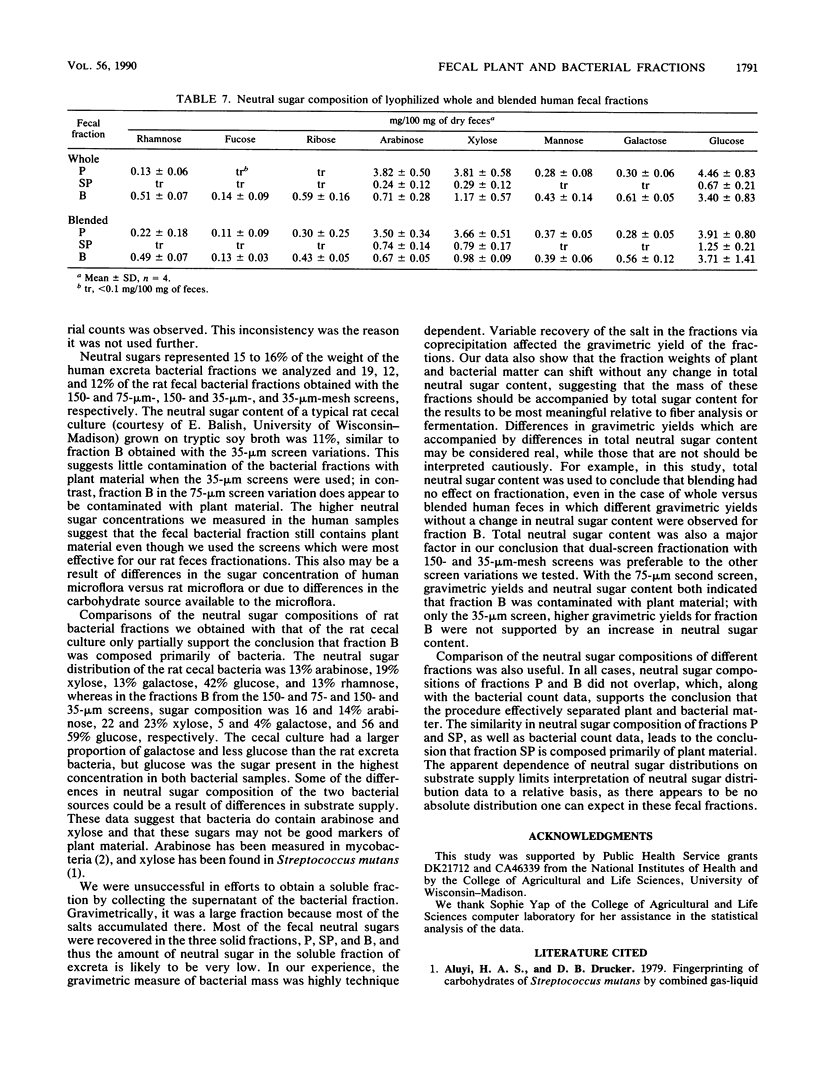Abstract
Separating dietary fiber from other polysaccharides in digesta and feces is necessary to understand its mechanisms of action. A gravimetric method that separates fecal plant and bacterial matter based on size and density was evaluated and modified to determine the plant and bacterial mass of lyophilized whole and blended rat and human feces. Three screen mech combinations (150 and 75 microns, 150 and 35 microns, 35 microns) were used with rat feces. Filtration of a homogenized rat fecal slurry sequentially through 150- and 35-microns-mesh screens versus 150- and 75-microns-mesh screens decreased the gravimetric recovery of bacteria from congruent to 35 to congruent to 25% of fecal dry weight and increased the plant fraction weight. Neutral sugar composition, determined by gas chromatography of alditol acetates, and bacterial counts of the fractions suggested that the decreased yield of bacterial fraction represented removal of plant material and not a loss of bacteria. Rat excreta contained 29.5% (dry weight) total neutral sugar, 88% of which was recovered in the plant material. Human feces containing wheat bran, fractionated with the 150- and 35-microns-mesh screens, was 21% neutral sugar, congruent to 65% of which was in the plant fraction. The plant fractions had more xylose and arabinose and less glucose than the bacterial fractions. Processing samples in a Waring blender had no adverse effect on the rat or human fecal bacterial counts. The use of this gravimetric method in combination with the sugar analysis of the fractions provided a better measure of plant and bacteria than only gravimetric yield.
Full text
PDF






Selected References
These references are in PubMed. This may not be the complete list of references from this article.
- Alvin C., Larsson L., Magnusson M., Mårdh P. A., Odham G., Westerdahl G. Determination of fatty acids and carbohydrate monomers in micro-organisms by means of glass capillary gas chromatography: analysis of Mycobacterium gordonae and Mycobacterium scrofulaceum. J Gen Microbiol. 1983 Feb;129(2):401–405. doi: 10.1099/00221287-129-2-401. [DOI] [PubMed] [Google Scholar]
- Brauer P. M., Slavin J. L., Marlett J. A. Apparent digestibility of neutral detergent fiber in elderly and young adults. Am J Clin Nutr. 1981 Jun;34(6):1061–1070. doi: 10.1093/ajcn/34.6.1061. [DOI] [PubMed] [Google Scholar]
- Marlett J. A., Johnson E. J. Composition of fecal fiber from human subjects. J Nutr. 1985 May;115(5):650–660. doi: 10.1093/jn/115.5.650. [DOI] [PubMed] [Google Scholar]
- Shinnick F. L., Longacre M. J., Ink S. L., Marlett J. A. Oat fiber: composition versus physiological function in rats. J Nutr. 1988 Feb;118(2):144–151. doi: 10.1093/jn/118.2.144. [DOI] [PubMed] [Google Scholar]
- Slavin J. L., Brauer P. M., Marlett J. A. Neutral detergent fiber, hemicellulose and cellulose digestibility in human subjects. J Nutr. 1981 Feb;111(2):287–297. doi: 10.1093/jn/111.2.287. [DOI] [PubMed] [Google Scholar]
- Stephen A. M., Cummings J. H. The microbial contribution to human faecal mass. J Med Microbiol. 1980 Feb;13(1):45–56. doi: 10.1099/00222615-13-1-45. [DOI] [PubMed] [Google Scholar]


